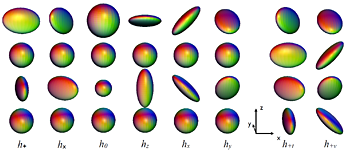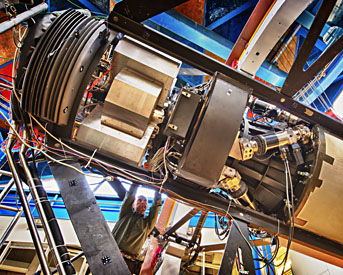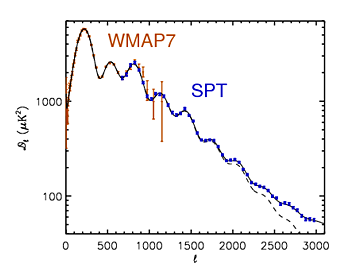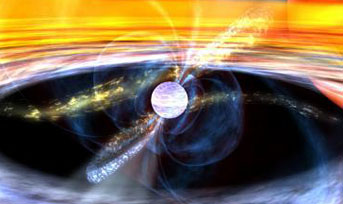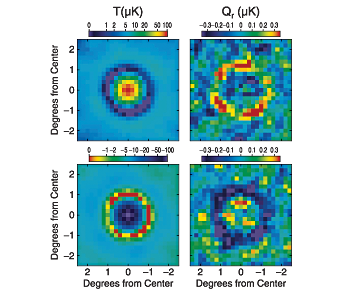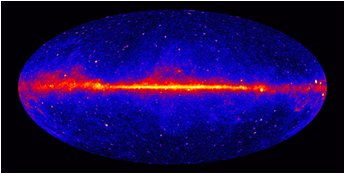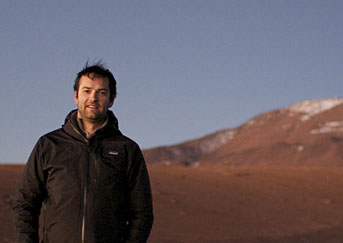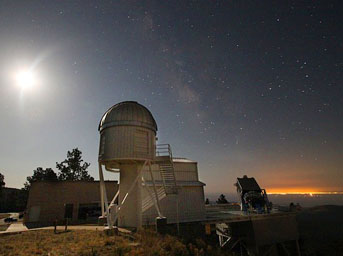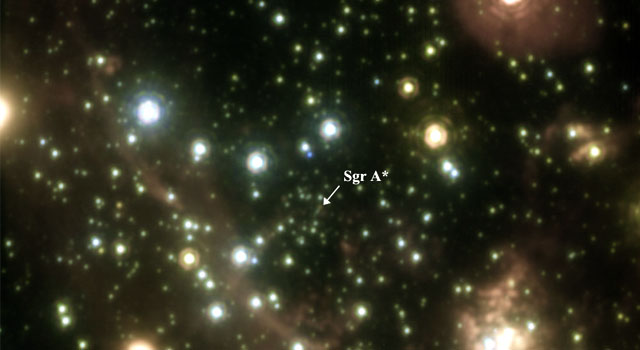 |
 |
 |
 |
 |
 |
 |
 |
 |
 |
 |
 |
|
Talks & Events
|
Colloquia: 2013
Covering the Bases One of the principal aims of cosmology today is to seek subtle correlations in primordial perturbations, beyond the standard two-point correlation that has been mapped precisely already, that may hint at new physics beyond that in the simplest single-field slow-roll models. I will describe in this talk a new class of such correlations and how they may be sought with galaxy surveys and in the CMB. I will then turn my attention to a new formalism, total-angular-momentum (TAM) waves, that my collaborators and I have recently developed. In most of the literature, cosmological perturbations are decomposed into Fourier modes, or plane waves. However, for calculations that aim to produce predictions for angular correlations on a spherical sky, a decomposition into TAM waves provides a far more direct and intuitive route from theory to observations. I will describe the formalism and illustrate with applications to cosmic shear, three-point correlation functions, and redshift-space distortions. Imaging instruments for the cosmic frontier This talk reviews the current technology used for wide field optical imaging in astronomy, with emphasis in the recently commissioned Dark Energy Camera. This technology has enabled new experiments in the cosmic frontier that are starting to produce results now. Finally, during this talk, I discuss how this field is transforming to allow future astronomical instruments with unprecedented scientific potential. New CMB Results from the South Pole Telescope The South Pole Telescope (SPT) recently completed a 2500 square degree survey of the sky in the 3mm, 2mm and 1.4 mm bands with an unprecedented combination of resolution, area, and sensitivity. The data from this survey has enabled a number of studies, including the most precise measurement of the sub-degree primordial CMB anisotropy to date. This talk will review this measurement and the resulting cosmological constraints. The new SPT data, in conjunction with data from the WMAP satellite and low-redshift measurements, leads to strong constraints on the number of neutrino-like particle species present in the early universe, the sum of the neutrino masses, and the shape of the power spectrum of primordial density fluctuations. I will also give a brief update on the status of SPTpol, the new polarization-sensitive receiver on the SPT. Neutron Star Radii and Masses Neutron stars offer the unique possibility of probing the equation of state of cold, ultradense matter. Understanding the properties of the neutron star interior is also important for predicting the observational appearance of short gamma-ray bursts, the end stages of neutron star coalescence, and the outcomes of supernova explosions. I will present the recent measurements of neutron star radii and masses. I will show how the combination of the tightly constrained radii and the discovery of a 2 solar mass pulsar allows for the first astrophysical inference of the pressure of cold matter above nuclear saturation density. I will discuss the implications of this measurement for nuclear theory and astrophysics. Towards ab initio simulations of star formation in turbulent molecular clouds Understanding how molecular clouds form in the interstellar medium and how they evolve to produce dense cores that eventually give birth to stars is an important unsolved problem in star formation. From a theoretical perspective, star formation is a challenging multi-scale problem that involves complex nonlinear interactions of gravity, turbulence, magnetic fields, radiation and feedback processes. I shall describe a self-consistent computational framework for modeling molecular cloud formation in the multiphase ISM as a first step to generate realistic initial conditions for star formation. Our approach is based on self-organization in the turbulent ISM and, with only a few control parameters, numerical experiments successfully reproduce the observed probability distributions of the molecular gas density, thermal pressure, magnetic field strength, as well as the core mass function. I shall briefly discuss the origin of Larson's scaling relations that naturally emerge in the model. CMB Results from WMAP and ACT Acoustic processes in the plasma which pervades the early Universe govern the shape of the anisotropy of the cosmic background which has been measured by WMAP and other probes, notably ACT and the South Pole Telescope. I'll describe what we have learned, and what we have not learned from precise measurements of the temperature and polarization anisotropy of the CMB. Once the Universe became transparent, these acoustic signals stopped propagating. The density variations associated with them have remained fixed in co-moving (expanding) coordinates. I'll finish by talking about CHIME, the Canadian Hydrogen Intensity Mapping Experiment, CHIME, a collaboration to build a novel radio telescope designed to measure these same acoustic features at the much later epoch when cosmic acceleration from dark energy is important. Gamma-ray detections of cosmic-ray acceleration by supernova remnants Supernova remnants have been considered prime suspects as accelerators of cosmic rays within our Galaxy for a long time. Gamma-ray observations have offered the promise of turning that suspicion into certainty for almost as long, but only recently high-energy gamma-ray telescopes, both the Fermi Large Area Telescope and AGILE, have provided data that can be used to look for direct evidence of protons in these sources. I will present the new results from Fermi that reveal the proton signature in two supernova remnants and put this in context with the growing catalog of GeV remnants detected by LAT and the remaining questions to be answered about Galactic cosmic rays. Shedding light on dark matter and astrophysical sources with gamma-ray anisotropy Gamma rays probe the most energetic processes in the universe and are a promising tool to search for signatures of new physics. One current mystery in high-energy astrophysics is the origin of the diffuse gamma-ray background. The contribution of undetected sources is expected to induce small-scale anisotropies in this emission, and these may provide a means of identifying and constraining the properties of its contributors. I will review the results of the first anisotropy analysis of the diffuse gamma-ray background measured by the Fermi Large Area Telescope, and highlight the new constraints this measurement has placed on high-energy source populations, focusing on implications for blazar population models and for a signal from the annihilation or decay of dark matter particles. I will also present new multi-wavelength techniques for unraveling contributors to diffuse emission. The secret lives of galaxy clusters Galaxy clusters have the potential to be highly accurate probes of cosmological parameters. However, they are also very interesting astrophysical objects in their own right! The properties that make clusters irritating to those who wish to use them for cosmology - deviations from sphericity and hydrostatic equilibrium, shocks, mergers, and a variety of baryonic processes - provide a tremendous amount of information about these massive beasts. I will present recent efforts to understand the effects that correctly modeling the properties of gas in cosmological simulations have on the observable properties of clusters, focusing on shocks and the non-thermal components of the intracluster medium, including cosmic rays and magnetic fields. The Road to 100 Earths The search for planets orbiting nearby stars has been one of the greatest success stories of the past decade, with hundreds of discoveries being made using Doppler, transit, microlensing, and direct imaging techniques. More than 2300 candidates have been detected with NASA's Kepler mission. Exoplanet detections have launched a subfield of astronomy that includes host star characterizations, measurements of planet radii and density, studies of atmospheres, interior structure, formation theory, and orbital evolution. The search for exoplanets is motivated by the question of whether life exists elsewhere. This drives our interest in the detection of planets that are similar to our own world: rocky planets with the potential for liquid surface water and plate tectonics; worlds that might harbor life that we can recognize. Importantly, we will need to discover not just a few, but hundreds of these worlds to eventually gain a statistical understanding of whether life is rare, common, or ubiquitous and ground-based telescopes offer an ideal platform for carrying out decade-long surveys. It is critical for follow-up studies (imaging, atmospheric studies) that these planets orbit nearby stars rather than stars at distances of the typical Kepler field star. In this talk, I will discuss how we plan to take what we've learned and push on to the next frontier: a search 100 Earths. Towards 1% measurements of cosmological distances with cosmic sound Measuring the accelerated expansion of the Universe with the goal of better understanding its underlying physics is one of the leading programs in cosmology today. The baryon acoustic oscillation technique is one of the foremost tools in our toolbox today. This talk will explain the underlying physics of this method and the reasons it is extremely robust to observational and theoretical systematic errors. I will then present the latest results from the SDSS and BOSS surveys, currently the most precise distance constraints from this method. These will include a new analysis technique to undo the effects of the nonlinear evolution of the density field and partially ''reconstruct'' the initial density field, and can reduce the distance errors by a factor of 1.7. I will discuss the implications of these measurements, and will conclude by discussing prospects for improvements in the immediate and not-so-immediate future. Effective Field Theories for Fluids and Superfluids I will present a novel field theoretical framework that captures the long-distance and low frequency dynamics of hydrodynamical systems. The approach is that of effective field theories, whose building blocks are the long-distance degrees of freedom and symmetries. Possible applications include questions in condensed matter physics, heavy-ion collisions, astrophysics, cosmology, and quantum hydrodynamics. Finally, this formulation naturally invites (and answers) new questions in classical hydrodynamics. High redshift starburst galaxies revealed by SPT, ALMA, and gravitational lensing The South Pole Telescope (SPT) has systematically identified a large number of high-redshift strongly gravitationally lensed starburst galaxies in a 2500 square degree cosmological survey of the millimeter (mm) sky. These sources are selected by their extreme mm flux, which is largely independent of redshift and lensing configuration. The flux magnification provided by the gravitational lensing enabled us to perform a spectroscopic redshift survey with the recently commissioned Atacama Large Millimeter Array (ALMA). We targeted 26 SPT sources and obtained redshifts via molecular carbon monoxide (CO) lines. We determine that roughly 40% of these sources lie at z>4, indicating the fraction of dusty starburst galaxies at high-redshift is far higher than previously thought. Two sources are at z=5.7, placing them among the highest redshift starbursts known, and demonstrating that large reservoirs of molecular gas and dust can be present in massive galaxies near the end of the epoch of cosmic reionization. These sources were additionally targeted with high resolution imaging with ALMA, unambiguously demonstrating them to be strongly gravitationally lensed by foreground structure. We are undertaking a comprehensive and systematic followup campaign to use these "cosmic magnifying glasses" to study the infrared background in unprecedented detail, inform the condition of the interstellar medium in starburst galaxies at high redshift, and place limits on dark matter substructure. I will discuss the scientific context and potential for these strongly lensed starburst galaxies, give an overview of our team's extensive followup efforts, and describe our latest science results. Dark Matter at Colliders While 27% of the Universe is made of dark matter, the particle identity of the dark matter still remains a mystery. Collider studies offers a complementary tool to explore the nature of the dark matter, in addition to dark matter direct and indirect detections. In this talk, I will discuss the collider studies of the dark matter, focusing on how to observe dark matter signals, and how to distinguish dark matter scenarios. In the first part of the talk I will discuss the model-independent approach for the monojet/monophoton plus missing ET signals, as well as model-dependent signatures of dark matter produced in the cascade decay chain of parent particles. The second part of the talk will focus on the study of distinguishing multiple component dark matter with traditional single particle dark matter. Infalling groups and galaxy evolution in the IMACS Cluster Building Survey From a photometric/spectroscopic study of galaxy clusters at z~0.4, using the wide field of the IMACS instrument on the Magellan-Baade telescope, we have studied infalling galaxies that were building typical rich clusters 4 billion years ago, and compared them to field galaxies at that epoch over the full range of galaxy environment. The results emphasize the important role of infalling groups of galaxies in building a cluster, and provide evidence that significant quenching of starforming galaxies occurs in such groups --- in both the cluster and field environment. Our study also suggests a new interpretation of the role that starbursts play in galaxy evolution. Status and Future of the APOGEE Project The Apache Point Observatory Galactic Evolution Experiment (APOGEE) in Sloan Digital Sky Survey III (SDSS-III) is a large-scale, near-infrared, high-resolution (R ≥ 22,500) spectroscopic survey of the Milky Way (MW) using a 300-fiber, cryogenic spectrograph operating over 1.51-1.70 µm (i.e., a large fraction of the H-band). Because of the lower H band dust extinction compared to that at optical wavelengths (AH / AV = 0.16), APOGEE effectively pierces through dust obscuration and will provide a vast, uniform database of chemical abundances and radial velocities for stars across all Galactic populations (bulge, thin and thick disks, halo). APOGEE started observations in May 2011 and in 3 years of SDSS-III bright time intends to observe of order 100,000 giant star candidates selected from the Two Micron All-Sky Survey (2MASS) across hundreds of sight lines with field limits ranging over H=11-13.5. With its high resolution and S/N (>100 per Nyquist-limit-sized pixel), APOGEE will determine precision radial velocities (presently at 100 m/s absolute accuracy and 30 m/s relative precision) and accurate abundances for numerous chemical species, including C, N, O and Fe, as well as other α, odd-Z, and iron-peak elements for its primary targets. About 5% of the APOGEE targeting is dedicated to a number of ancillary science programs that are already yielding interesting results. To date the APOGEE survey has collected more than 350,000 spectra of over 65,000 distinct stars. I will give an overview of APOGEE and some of its initial findings, and lay out our plans to expand the APOGEE survey for another 6 years and in both the Northern and Southern Hemispheres in SDSS-IV. Making Hay with ALFALFA The recently completed ALFALFA blind HI survey has produced an unprecedented catalogue of 21-cm detected objects in the local universe out to z = 0.06. With a sensitivity more than an order of magnitude better than previous wide-field blind HI surveys, ALFALFA represents the current state-of-the-art in neutral hydrogen searches. In this talk I will give a brief overview of the ALFALFA survey, then will describe two optical follow-up projects led by our group at Indiana. The first is a large narrow-band H-alpha imaging study of a volume-limited sample of ALFALFA sources. The second is a deep imaging study of nearby HI clouds that have the characteristics of being low-mass dark matter halos. One of the objects uncovered in this latter study is a nearby dwarf galaxy with fairly unique properties that we dubbed Leo P. Observation of High Energy Neutrinos at IceCube Cosmic rays above the ankle (10^18 eV) are the universe's most energetic particles and must be produced in the universe's most energetic objects -- but which ones? and how? Neutrinos should be produced in whatever the cosmic accelerators are and should provide unique insights into their production mechanisms. Recent searches for high-energy (> 100 TeV) neutrinos at the antarctic IceCube neutrino observatory have produced the first evidence for a neutrino population beyond what is readily explained by neutrino production in the Earth's atmosphere from cosmic ray interactions, including the observation of several events with energies above 1 PeV -- the highest energy neutrinos ever observed. This talk will discuss the current status of these astrophysical neutrino searches in IceCube and prospects for the future. Feedback from AGN In Massive Galaxies: The Importance of Momentum Driving Black holes, resident in the centers of galaxies, will be fed by accretion of ambient gas whenever gas reaches those central regions. This can be due to mergers, but even without mergers the evolution of the stellar populations of normal galaxies provides very large amounts of gas, as stars pass through the planetary nebula stage, the total mass release being greater than 1011 Msolar for massive ellipticals. Much of that gas will cool and fall to the centers of the systems, where it will induce starbursts and accretion events onto the central black holes with resultant AGN outbursts. The mass, momentum and energy in these outbursts can have dramatic consequences for the growth of the BH and for the ambient galaxy. Most AGN feedback treatments do not include the mass and momentum components. We follow these events with 1D, 2D and 3D hydrodynamic codes. BH growth is similar to what has been found by others, but the momentum driving produces much more energetic winds than does thermal feedback reducing star formation and thermal X-ray emission. Observable consequences include the narrow line AGN absorption lines, shock accelerated synchrotron emitting particles and wind driven bubbles in the IGM. In addition, we find that the feedback strongly inhibits inflow, causing episodic accretion and a low “duty cycle”. The simulations help us to understand many phenomena including the black hole stellar mass relation, “quenching” of the mass growth, the X-Ray luminosity of ellipticals, the incidence of the “E+A” phenomena and the observed fact that most of the black holes found in galactic centers are found in the “off” state. Star formation regulated by magnetic reconnection Recent years have been marked by a notable change in the star formation paradigm. Instead of quasi-static molecular clouds slowly evolving under the influence of gravity and ambipolar diffusion a new picture with more action and dynamics emerged. Within new understanding of interstellar processes, the molecular clouds are associated with turbulent density fluctuations and the structure of the interstellar medium evolves fast on the sound crossing times. I appeal to the advances in understanding of magnetic reconnection in turbulent medium and demonstrate that fast reconnection can cause of the efficient magnetic field diffusion that does not depend on the degree of media ionization. I shall show that a process that I term "reconnection diffusion" can be responsible for efficient removing magnetic flux during star formation. For the giant molecular clouds (GMCs) and for many cloud cores the resulting rates of magnetic field removal dominate the ambipolar diffusion rates in partially ionized gas. I shall show that numerical simulations validate the concept of "reconnection diffusion" and that this process can successfully explain the existing observational data on magnetic field -- density correlations in diffuse media, removal of magnetic fields from clouds and accretion disks on the time scale less than the ambipolar diffusion as well as the recent results by Crutcher et al. on the magnetization of cores and envelops. I shall discuss the implications of the reconnection diffusion process for the theory of star formation. Foiling LCDM I will discuss consistency tests of the standard LCDM paradigm in light of the comparison between recent Planck CMB results and local measurements, using alternative models as foils. The Galactic Center: Unveiling the Heart of our Galaxy The proximity of the center of our Galaxy has presented us with a unique opportunity to study a galactic nucleus with orders of magnitude higher spatial resolution than can be brought to bear on any other galaxy. This advantage, along with the recent advances in high angular resolution imaging technologies, has allowed the first observations of individual stars at the very heart of a galaxy. After more than a decade, such observations have transformed the case for a supermassive black hole at the Galactic center from a possibility to a certainty, thanks to measurements of individual stellar orbits. The rapidity with which these stars move on small-scale orbits indicates that 4 million times the mass of the sun resides within a region comparable to the size of our solar system and provides the best evidence yet that supermassive black holes, which confront and challenge our knowledge of fundamental physics, do exist in the Universe. Subsequent high-resolution imaging studies of the Galactic center have shown that the stellar population near our Galaxy's supermassive back hole is quite different from the predications of theoretical models for the interaction between central black holes and their environs (an essential input into models for the growth of nuclear black holes). In particularly, the observations have revealed an abundance of young stars in a region that is inhospitable to star formation and, conversely, a dearth of old stars where as a stellar cusp is expected. Further improvements in measurement precision should enable tests of Einstein's theory of General Relativity in the extreme environment near a supermassive black hole. Extragalactic Archeology One of the main avenues for understanding the formation and evolution of galaxies is through studying their present day stellar populations. A new generation of population synthesis tools that we have been developing are now capable of extracting an unprecedented amount of information from high quality spectra of galaxies. In this talk I will present results from an ongoing program aimed at measuring the stellar initial mass function and detailed elemental abundance patterns of early-type galaxies over the interval 0 < z < 1. Current data suggest that the IMF varies systematically across the galaxy population, with implications both for star formation theory and the inferred dark matter content in the central regions of galaxies. Constraints on the abundances of the alpha elements, iron peak elements, and neutron capture elements offer the promise of reconstructing the detailed star formation histories of these now dormant galaxies. Measuring the evolution of these quantities through cosmic time will provide new constraints on the assembly histories of galaxies and will open up a new era of 'extragalactic chemical tagging'. Neutrino Quantum Spookiness: Collapsing Stars, Supernovae, and the Cosmos Collapsing stellar cores and the early universe are fantastic engines for generating neutrinos, ghostlike particles which interact with matter only through the aptly named weak interaction and gravitation. However, neutrinos can more than make up for these feeble interactions with huge numbers. They can even come to dominate the energetics and element synthesis in the early universe and supernovae. But the way neutrinos interact with matter depends on which of three "flavors" they come in, i.e., electron, muon, or tau flavor. We therefore must determine how neutrino flavor changes as these particles move through their surroundings. This is a tricky, new kind of quantum mechanics problem. The advent of supercomputers has allowed us to follow this process in places, like supernova cores, where the flavor states of the neutrinos determine how flavor changes. And yes, this process is fiercely nonlinear. The results are startling and unexpected. Neutrinos can undergo collective flavor oscillations, producing signatures akin to domain formation in familiar condensed systems like ferromagnets. These signatures, if detected, could give us insights into astrophysical processes, like where the elements come from, but also into as yet unmeasured fundamental particle physics and cosmology issues, e.g., the neutrino mass hierarchy, the neutrino magnetic moment, and dark matter. Future high precision measurements, especially of the cosmic background radiation, promise to box-in many currently outstanding issues in neutrino physics. Cosmic Calibration or: How I Learned to Stop Worrying and Love Supercomputers Cosmology is now entering one of its most scientifically exciting phases. Decades of surveying the sky have culminated in the celebrated "Cosmological Standard Model". Yet, two of its key pillars, dark matter and dark energy -- together accounting for 95% of the mass-energy of the Universe -- remain mysterious. Deep fundamental questions demand answers: What is dark matter made of? Why is the Universe's expansion rate accelerating? Should general relativity be modified? What is the nature of primordial fluctuations? What is the exact geometry of the Universe? Next-generation observatories will open new routes to understand the true nature of the "Dark Universe". These observations will pose tremendous challenges on many fronts -- from the sheer size of the data that will be collected (more than a hundred Petabytes) to its modeling and interpretation. The interpretation of the data requires sophisticated simulations on the world's largest supercomputers. The cost of these simulations, the large number of modeling parameters, the uncertainties in our modeling abilities, and the fact that we have only one Universe that we can observe opposed to carrying out controlled experiments, all come together to create a major test for the process of scientific inference. In this talk I will give a very brief introduction to the Dark Universe and outline the challenges ahead. To combat these challenges, close cross-disciplinary collaborations between physicists, statisticians, and computer scientists will be crucial. I will discuss two key advances brought about by successful collaboration: (i) the development of HACC, a new N-body code that enables us to carry out very large cosmological simulations, and (ii) the cosmic calibration framework which melds sophisticated statistical methods with simulation and modeling inputs to attack the problem of scientific inference. Testing Gravity by Poking the Moon with a Laser Laser range measurements between the earth and the moon have provided some of our best tests to date of general relativity and gravitational phenomenology--including the equivalence principle, the time-rate-of-change of the gravitational constant, the inverse square law, and gravitomagnetism. APOLLO (the Apache Point Observatory Lunar Laser-ranging Operation) is now collecting measurements at the unprecedented precision of one millimeter, which will produce order-of-magnitude improvements in a variety of gravitational tests. Experimental performance, evidence for dust-induced degradation of the reflectors, finding the lost Soviet Lunokhod 1 reflector, project status and science outlook will be discussed. Origins of Gas Giant Planets Several giant planets have now been directly imaged, offering the first view of extrasolar planets at wide separations from their host stars. Formation of these objects by either leading theory--core accretion or gravitational instability--presents substantial difficulties. These challenges may be reinterpreted as opportunities. In this talk, I will demonstrate how to use upcoming constraints from direct imaging to distinguish between theories of giant planet formation. Along the way, I will discuss whether gravitational instability could have formed the iconic directly-imaged planetary system HR 8799, present a new theory of planetary core growth in the presence of gas that extends the reach of core accretion to large stellocentric distances, and show how the atmospheric compositions of giant planets record signatures of their formation locations. Cosmological simulations of the formation of galaxies Cosmological hydro simulations can give unique insight into the formation and evolution of galaxies and their interplay with the intergalactic medium. They have realistic initial conditions, they can provide representative samples of galaxies that span a wide range of mass and environment, they can follow their evolution over time, and they can simultaneously model both the galaxies the intergalactic medium around them. The drawback of cosmological simulations is, however, their limited resolution and the importance of subgrid models. I will give an overview of the ingredients of the simulations and discuss recent developments, current issues and bottlenecks. I will then use the simulations to highlight the key role that self-regulation plays in the evolution of galaxies. Finally, I will demonstrate that the feedback processes that appear to be needed to match the observations have a dramatic impact on observational cosmology. Large-Scale Structure in the intergalactic medium and the formation of galaxies: What we are learning from BOSS in SDSS-III The Baryon acoustic OScillations Survey in SDSS-III is obtaining more than one hundred thousand absorption spectra of quasars at redshift z>2. This opens a new window for studies of large-scale structure at high redshift, which has already resulted in the first detection of the Baryon Acoustic Oscillation peak at these redshifts, using absorption of intergalactic gas. Cross-correlations of the Lyman alpha absorption with other objects, among them Damped Lyman Alpha absorption systems as tracers of high-redshift galaxies, reveals their spatial distribution and provides new clues on how galaxies were forming at this epoch, when the universe was about 3 billion years old. Image: Contours of the redshift-space cross-correlation of damped Lyman alpha systems with the Lyman alpha forest absorption, comparing the observation (left) with the linear theory prediction (right). |

